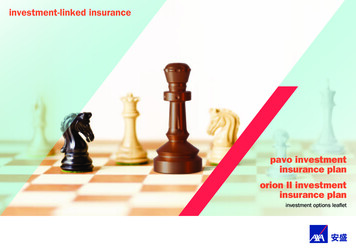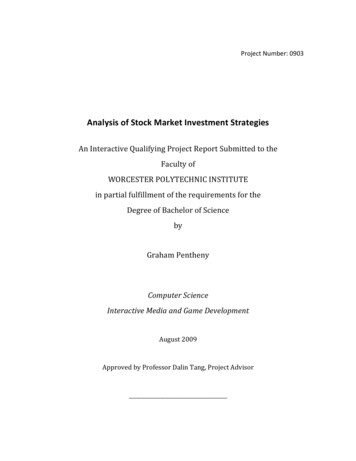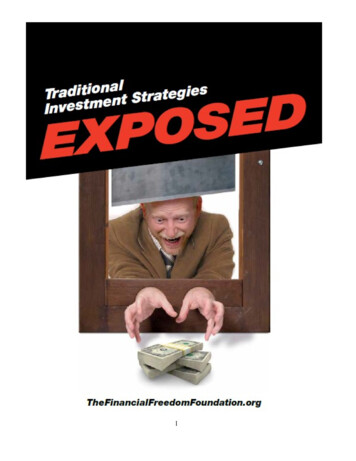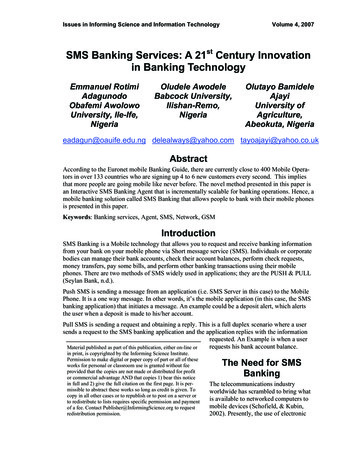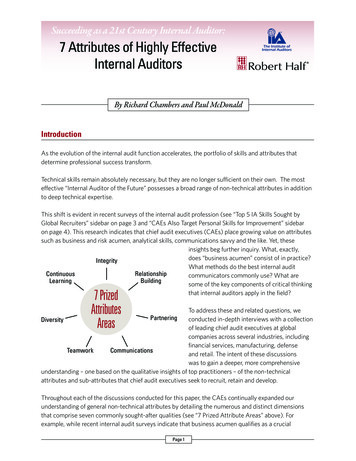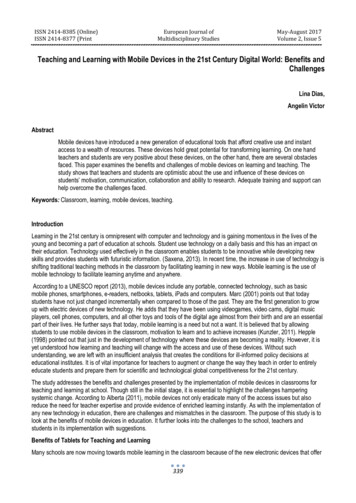
Transcription
Investment Strategies for the 21st CenturyFrank Armstrong called on his 30 years of experience as a portfolio manager andinvestment counselor to write Investment Strategies for the 21st Century, as far as weknow, the first investment book ever published on the Internet. The book wasoriginally commissioned by GNN's Personal Finance Center and was serialized therefrom January 1994 until the demise of GNN in December of 1996.GNN was a pioneer Internet content provider. During the infancy of the World WideWeb, GNN set the standard for high quality in the industry. GNN was later acquired andsubsequently dismantled by America On Line. Frank's book was later serialized onfundsinteractive.com, the world's largest mutual fund discussion group.Frank is the president and founder of Investor Solutions, Inc., a fee-only investment advisormanaging accounts for clients all over the globe.The book, which has become an Internet cult classic, won instant world wide acclaim as one of thefinest non-technical finance and investment guides ever written. "I love finance! I don't think it has tobe dull, and it doesn't have to be mysterious. I want Joe Sixpack to read, enjoy and profit from therevolution on Wall Street." says Frank. "Investors of very modest means can construct portfolioswhich rival the sophistication of multi billion dollar institutions. Using no-load mutual funds, everyonecan invest economically and effectively and have confidence that they will be able to meet theirfinancial goals."So, if you are an investor that aspires to his own yacht, or just a comfortable and secure retirement,read on.Introduction Preparing for Tomorrow's ChallengesChapter 1Gathering IntelligenceChapter 2Assessing the RiskChapter 3Taming the BeastChapter 4A Nibble from the Free LunchChapter 5Travels on the Efficient FrontierChapter 6The Asset Allocation DecisionChapter 7The Efficient Market DebateChapter 8Can Managers Add Value?Chapter 9Doing It with StyleChapter 10Fun with NumbersChapter 11Setting Your GoalsChapter 12Building Your PortfolioChapter 13Portfolio TacticsChapter 14Pigs, Mousetraps & RevolutionChapter 15It's a Jungle Out ThereChapter 16The Joys of Fund SelectionChapter 17Fund AlternativesChapter 18The Good, the Bad, and the UglyChapter 19Tending Your GardenChapter 20Education and Retirement: Ouch!Chapter 21Investor, Heal ThyselfChapter 22All the Wrong Stuff
Chapter 23Will the Real Investment Advisor Please StandUp?Chapter 24Pulling It All Together
Introduction:Preparing for Tomorrow's ChallengesMost Americans have a very poor understanding of how the world's investment markets work, andhow to harness the tremendous power of the markets to meet their needs.After more than 22 years of counseling investors, I am convinced that Americans must invest more,and smarter.I have never seen an investor that set out to do something dumb. However, investors have beenbadly shortchanged in their financial education. Recently colleges and universities have enhancedtheir courses in finance. That's only natural because most of the pioneering work was done inacademia. But if your MBA is more than 5 years old, you have some serious catching up to do.In some respects American investors are the victims of a sales system designed to milk them. Badadvice often turns out to be far more profitable than good advice.In other respects, these same investors are their own worst enemies. They insist on shootingthemselves in the foot. Fear and emotion rule too many investment choices.The solution to both problems lies in better understanding.These articles will outline how investors can develop - and implement - effective investment strategiesfor the 21st century.PlungeMy father witnessed one of the defining moments of American history. As a very young man, he wasa runner on Wall Street during the Great Crash of 1929. In the middle of the panic, one ruinedinvestor jumped from his office window.As the day progressed, a gallows humor developed. My father and his young friends began to jokethat it was necessary to keep looking skyward to prevent being squashed by falling financiers.While only one unfortunate actually took the plunge, he made an indelible impression not only on thesidewalks below, but upon the psyche of the entire American people. Over time, the myth ofinvestors raining down on Wall Street became firmly entrenched.The Crash was shortly followed by the Great Depression, a devastating and traumatic low point inAmerican history. So great was the suffering during the Depression that it still affects the Americanconventional wisdom. The lore has been handed down to succeeding generations. Today, almost 65years later, many of our attitudes about investing are shaped by lessons learned then. Too bad mostof the lessons we learned from that disaster are wrong!Legacy of the DepressionOne of the enduring legacies of the Depression is a deep distrust of the stock market. The stockmarket became perceived as risky, irresponsible, foolish, and dangerous. Everyone knew someone orwhole families that had been "wiped out" by the crash.The Role of Margin Investing in the CrashThe real culprit in the crash, speculation with only a 10% margin requirement, is seldom mentioned.
Margin greatly increases both risk and reward in an investment portfolio. An investor who buys 10 ofstock with 1 down will see his equity double with only a 10% increase in stock prices. Conversely,his equity will be wiped out if stock prices fall only 10%.An investor riding on his margin limit will immediately receive a margin call if his share prices decline.He is then required to deposit additional cash into his account to bring him back up to his marginrequirements. If he is unable to promptly inject additional capital, his portfolio will be sold for him inorder to pay his debts. If a large number of investors receive margin calls at once, the resulting saleswill further decrease equity prices.Notice that if investors had no margin, they simply experienced a 10% reduction in equity. They haveno margin calls. They are not required to deposit additional cash. They are not forced to sell. Theycan, if they wish, choose to ignore the entire event. While not pleasant, financial panic is also notlikely.Other Factors During the CrashDuring the market crash of 1929, the central bank did exactly the wrong thing by restricting credit.With credit restricted, even wealthy investors were unable to meet their margin calls. The systemwent into a free fall.Most investors have not considered that in the depression that followed the crash, the economyunderwent a significant deflation. Investors that held unleveraged, diversified, balanced portfoliosactually saw their real worth increase even though prices of both stocks and bonds fell. Prices ofgoods and services fell far faster than the value of their financial assets. (Stocks fell in real terms, butbonds increased in value as interest rates fell.)After the Depression, as the war economy heated up, financial assets continued to outperforminflation. The value of diversified portfolios continued to grow in real terms.Deposit InsuranceA large number of banks failed during the Depression. To restore confidence in the banking system,the government developed federal deposit insurance. Deposit insurance provided Americans with a"zero-risk" savings vehicle.Americans, who now blamed financial assets rather than inappropriate leverage for the crash, flockedto the banks. Several generations of Americans now have been carefully trained by their bankers toregard "insured" savings as responsible, conservative, and wise. The truth - as we shall see - is thatlong-term saving rates have failed to generate real, after-tax, after-inflation rates of return.In 1929 there were lots of problems in the world's economy. The crash certainly was not the solecause of the depression. Still, most Americans link the two together.Today the average American has serious misperceptions about the nature of stock market risk, in partbased on events that occurred long before his birth. As a result he is woefully prepared to meet hisfinancial needs of the future. Solving tomorrow's problems is not likely to be successful if based onyesterday's flawed analysis.Conventional WisdomJohn Kenneth Galbraith was a true giant among men (he stood 6'8"): a Harvard economics professor,John F. Kennedy's faculty advisor and later confidante, member of the President's Council ofEconomic Advisors, a power in the Democratic party, ambassador to India, acclaimed author, andgeneral all-around neat guy.Galbraith proposed the concept of Conventional Wisdom, which he defined as ideas which are soingrained in our culture that no one ever questions them. Unfortunately, conventional wisdom is oftenwrong. Galbraith argued persuasively that public policy built on conventional wisdom was doomed to
failure. By challenging and exposing conventional wisdom, Galbraith was able to shape the economicand political policy debate for a generation.Conventional wisdoms can continue to influence our behavior in spite of overwhelming, abundant, andirrefutable evidence that they are wrong. We often simply cannot let go of them. These ideas fromHell often simply refuse to die, no matter how often struck down.An investment plan built on conventional wisdom is doomed. A successful investment strategy for the21st century requires a clear understanding of the environment. You must re-examine all of yourpreconceived notions, abandon the useless, and be willing to incorporate the many useful newadvances into your strategy.Of course, not all the problems facing the American investor today are the result of grandfather'sstories of the Depression. But most Americans would be well served to take a quick review of financefrom the ground up.Tomorrow's ChallengesTomorrow's problems are distinctly different from those that faced our grandfathers. Our grandfatherscould expect to work to at least age 65, and die promptly within a few months or years afterretirement. The new Social Security system would pay for most of his reasonable needs, and foreach retiree receiving benefits, several hundred were contributing. With a limited life expectancy,inflation wouldn't have time to seriously erode his income. He anticipated an extended family to carefor him, and support him if need be.Today's American sits upon a retirement time bomb. As industry downsizes, right sizes and cuts fat,he may be forced into retirement long before he expected or is economically prepared to. "Moderate"inflation is a government policy. Demographic trends are particularly discouraging. With increasedlongevity, a 60-year-old and his wife must project a 35-year retirement for at least one of them.Social Security will provide only a small fraction of his retirement needs. By the year 2020, for eachretiree receiving benefits, only 1.5 will be left in the work force to support him. This eliminates anychance for real benefits increases and sets the groundwork for an intergenerational war. Extendedfamilies are a thing of the distant past. Savings rates are at historic lows, and the lowest in thedeveloped economies.Meanwhile, our politicians, most of whom have never experienced a vision farther out than the nextelection, are falling all over themselves to proclaim that Social Security is sacred, and will not besubject to any cuts. Hopefully, most Americans are taking that with a grain of salt. We are going tohave to take responsibility for our own financial futures by investing more.The private pension system is under systematic and continuous attack by a government desperate forincreased revenue. Limitations on both deductibility of contributions and withdrawal of benefits erodethe system each year. Meanwhile, increases in insurance, funding, and regulatory costs have madedefined benefit plans less and less attractive for employers. It shouldn't surprise us that feweremployees will enjoy the traditional pension.Help ArrivesWonderful new tools are available to help. Contributions by academia and institutions have changedthe face of modern finance. Institutions and multi-billion-dollar funds have used these advances foryears to improve their results. By now, they have stood the test of time. Best of all, you can easily,effectively and economically translate the new techniques to your portfolio. You don't have to be abillionaire to invest like one. You just have to know the "secrets."That's right. There are secrets. But they may not be the ones you think. I'm not going to share anyhot tips, or predict when the next big rally or crash is coming. So if that's what you are looking for,you will be disappointed. But if you would like to get consistent, above-average, long-term resultswithout taking a lot of risk, read on.
Financial economics and management have made huge advances in the last few years. To benefitwe will need to unlearn a lot of what we think we know. Today we know that the appropriateapproach to managing investments is at the portfolio level through asset allocation, and that risk canbest be moderated through the tenets of Modern Portfolio Theory. Yesterday's preoccupation withindividual stocks, market timing, and manager selection turns out to be somewhere between uselessand dangerous to your financial health.Most major institutions and pension plans have quietly adopted this approach. But it is almostunknown in the retail market. Very little about the revolution on Wall Street filters down to the public.The major brokerage houses prefer to focus on the far more profitable (for them), but less effectivetraditional stock, bond and mutual fund business. Make no mistake about it, Wall Street's only realcommitment is to their own bottom line. Investor returns are clearly secondary. The prevailing mottocan be summed up in just two words: Sell More!Many stockbrokers haven't taken the time to learn investment management fundamentals.Stockbrokers are salespeople, not competent financial advi
Investment Strategies for the 21st Century Frank Armstrong called on his 30 years of experience as a portfolio manager and investment counselor to write Investment Strategies for the 21st Century, as far as we know, the first investment book ever published on the Internet. The book was originally commissioned by GNN's Personal Finance Center and was serialized there from January 1994 until the .

